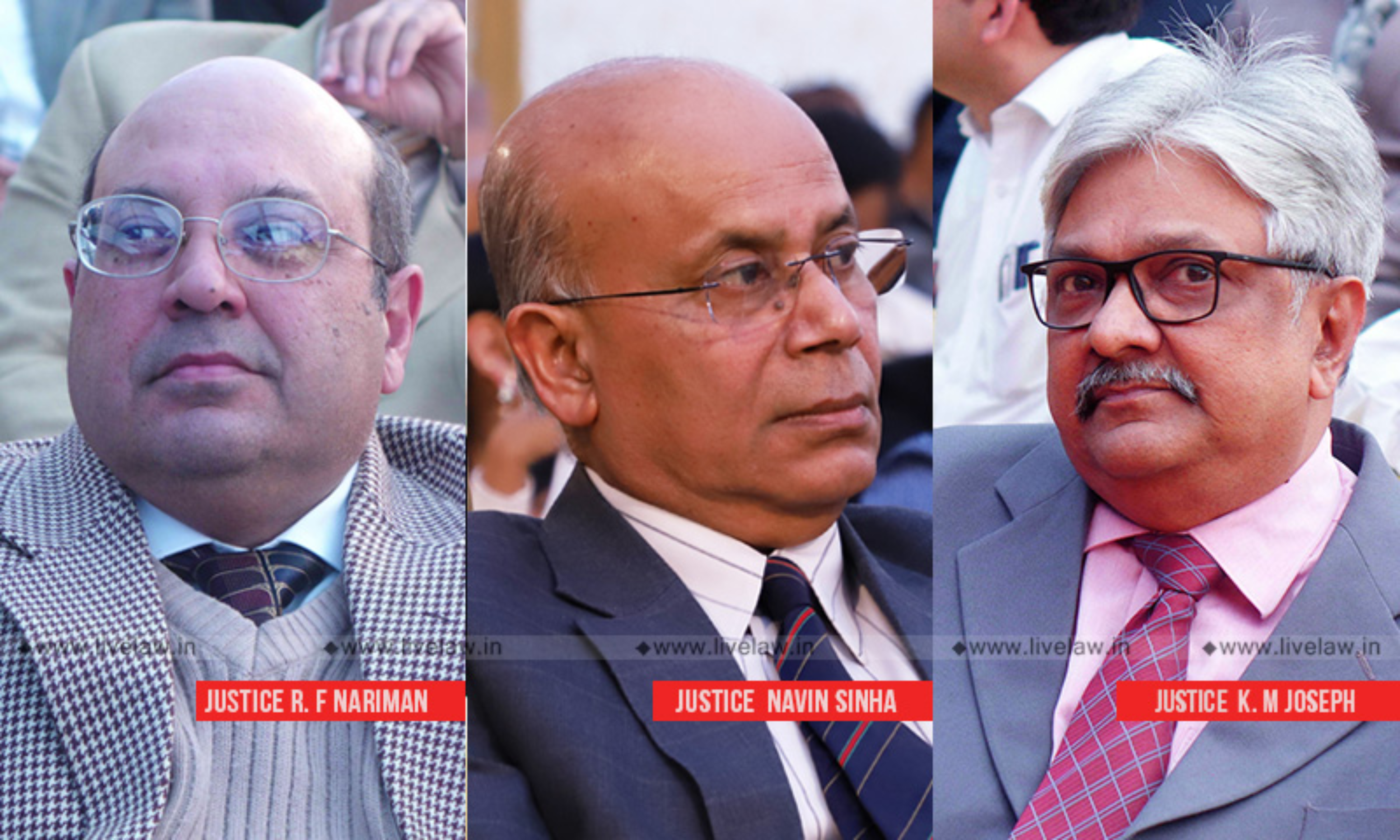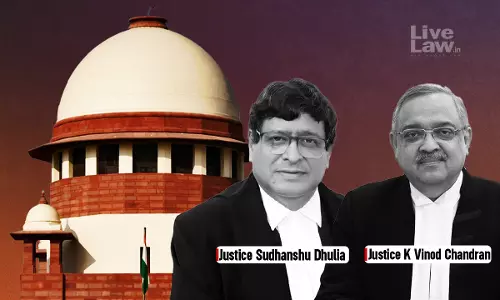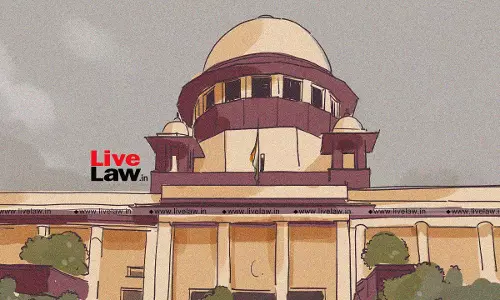
The Supreme Court on Tuesday upheld the constitutional validity of Sections 3, 4 and 10 of the Insolvency and Bankruptcy Code (Amendment) Act 2020.A bench comprising Justices RF Nariman, Navin Sinha and KM Joseph had considered the petitions. Justice KM Joseph authored the judgment delivered in Manish Kumar v Union of India and others and connected cases.While upholding the amendments, the...
The Supreme Court on Tuesday upheld the constitutional validity of Sections 3, 4 and 10 of the Insolvency and Bankruptcy Code (Amendment) Act 2020.
A bench comprising Justices RF Nariman, Navin Sinha and KM Joseph had considered the petitions. Justice KM Joseph authored the judgment delivered in Manish Kumar v Union of India and others and connected cases.
While upholding the amendments, the court provided the following reliefs exercising powers under Article 142 of the Constitution :
(1)If any of the petitioners move applications in respect of the same default, as alleged in their applications, within a period of two months from today, also compliant with either the first or the second proviso under Section 7(1), as the case may be, then, they will be exempted from the requirement of payment of court fees
(2)Secondly, we direct that if applications are moved under Section 7 by the petitioners, within a period of two months from today, in compliance with either of the provisos, as the case may be, and the application would be barred under Article 137 of the Limitation Act, on the default alleged in the applications,which were already filed, if the petitioner file applications under Section 5 of the Limitation Act, 1963, the period of time spent before the Adjudicating Authority, the Adjudicating Authority shall allow the applications and the period of delay shall be condoned in regard to the period,during which,the earlier applications filed by them, which is the subject matter of the third proviso, was pending before the Adjudicating Authority.
(3) We make it clear that the time limit of two months is fixed only for conferring the benefits of exemption from court feesand for condonation of the delay caused by the applications pending before the Adjudicating Authority.In other words, it is always open to the petitioners to file applications, even after the period of two months and seek the benefit of condonation of delay under Section 5 of the Limitation Act, in regard to the period, during which, the applications were pending before the Adjudicating Authority, which were filed under the unamended Section 7,as also thereafter
Section 3 of the IBC(Amendment) 2020 inserted certain additional conditions for homebuyers to initiate insolvency proceedings against defaulting builders. The said provision, adds certain provisos to Section 7 of the Insolvency and Bankruptcy Code (IBC) to state there should be at least one hundred real estate allottees or ten percentage of the total number of allottees, which ever is lesser, to maintain an insolvency petition in respect of a real estate project. The amendment also stated that the application of Section 3 of the amendment Act shall be retrospective, affecting pending applications.
The petitioners challenged the additional conditions imposed on homebuyers as 'arbitrary and discriminatory' amounting to 'illegal classification'.
They made reference to the SC decision in Pioneer Urban Land and Infrastructure case, which upheld the right of a homebuyer to move insolvency petition against a defaulting builder.
The Court had passed an interim order directing status quo on the pending applications filed by homebuyers against builders.
Highlighting the practical difficulties in homebuyers coming together to file joint application, one of the petitions said :
"the effect of the Impugned Act is that in cases wherein the Corporate Debtor has availed loans only from individuals, till the time the Creditors do not prefer an Application jointly against the Corporate Debtors, the management of the defaulting company continues to be in control, even after repeated defaults, which is completely contrary to the object of the IBC.
Section 4 of the Amendment Act 2020 inserted the following explanation to Section 11 :
Explanation II.-For the purposes of this section, it is hereby clarified that nothing in this section shall prevent a corporate debtor referred to in clauses (a) to (d) from initiating corporate insolvency resolution process against another corporate debtor."
The petitions also challenged Section 10 of the Act which inserted Section 32A in the IBC, whereby the liability of a Corporate Debtor, will cease to exist on the date a Resolution Plan is approved and new management takes over the Corporate Debtor.
This, according to the petitioners, leaves the individual creditor without remedies.
While rejecting the arguments, the Supreme Court held "we cannot also lose sight of the fact that the Legislature has power to impair and take away vested rights".
Imposing threshold on homebuyers application upheld
While upholding Section 3 of the IBC Amendment Act 2020, which introduced the threshold limit for homebuyers application for insolvency, the SC observed :
"Insisting on a threshold in regard to these categories of creditors would lead to the halt to indiscriminate litigation which would result in an uncontrollable docket explosion as far as the authorities which work the Code are concerned. The debtor who is apparently stressed is relieved of the last straw on the camel's back, as it were, by halting individual creditors whose views are not shared even by a reasonable number of its peers rushing in with applications. Again, as in the case of the allottees, this is not a situation where while treating them as financial creditors they are totally deprived of the right to apply under Section 7 as part of the legislative scheme. The legislative policy reflects an attempt at shielding the corporate debtor from what it considers would be either for frivolous or avoidable applications.
What we mean by avoidable applications is a decision which would not be taken by similarly placed creditors keeping in mind the consequences that would ensue not only in regard to persons falling in the same category but also the generality of creditors and other stakeholders. All that the amendment is likely to ensure is that the filing of the application is preceded by a consensus at least by a minuscule percentage of similarly placed creditors that the time has come for undertaking a legal odyssey which is beset with perils for the applicants themselves apart from others. As far as the percentage of applicants contemplated under the proviso it is clear that it cannot be dubbed as an arbitrary or capricious figure. The legislature is not wanting in similar requirements under other laws. The provisions of the Companies Act, 2013 and its predecessors contained similar provisions. Allowing what is described as 'lone Ranger' applications beset with extremely serious ramifications which are at cross purposes with the objects of the code. This is apart from it in particular spelling avoidable doom for the interest of the creditors falling in the same categories. The object of speed in deciding CIRP proceedings would also be achieved by applying the threshold to debenture holders and security holders. The dividing line between wisdom or policy of the legislature and limitation placed by the Constitution must not be overlooked"(paragraph 220)
"All that has happened is the Legislature in its wisdom has found that the greater good lies in conditioning an absolute right which existed in favour of an allottee by requirements which would ensure some certain element of consensus among the allottees. It must be remembered that the requirement is a mere one-tenth of the allottees. This is a number which goes to policy and lies exclusively within the wisdom of the Legislature. Hence, we have no hesitation in repelling the contentions in this regard"(paragraph 211)
Read More on this aspect - Minimum Threshold For Homebuyers' Insolvency Process Against Builder Shields Frivolous & Avoidable Applications : Supreme Court
Explanation II inserted to Section 11 upheld
The Court also upheld Section 4 of the Amendment Act 2020 which inserted Explanation II to Section 11 as a "clarificatory amendment"
The judgment observed :
"It could never had been the intention of the Legislature to create an obstacle in the path of the corporate debtor, in any of the circumstances contained in Section 11, from maximizing its assets by trying to recover the liabilities due to it from others. Not only does it go against the basic commonsense view but it would frustrate the very object of the Code, if a corporate debtor is prevented from invoking the provisions of the Code either by itself or through his resolution professional, who at later stage, may, don the mantle of its liquidator. The provisions of the impugned Explanation,thus,clearly amount to a clarificatory amendment.A clarificatory amendment, it is not even in dispute, is retrospective in nature.
The Explanation merely makes the intention of the Legislature clear beyond the pale of doubt. The argument of the petitioners that the amendment came into force only on 28.12.2019 and, therefore, in respect to applications filed under Sections 7, 9 or 10, it will not have any bearing, cannot be accepted.The Explanation, in the facts of these cases, is clearly clarificatory in nature and it will certainly apply to all pending applications also"(para 243)
Rejecting the challenge on the ground of arbitrariness under Article 14, the Court said :
"We are unable to understand how it could be described as being arbitrary for the Legislature to clarify its intention through the device of an Explanation."
Section 32A Upheld
Section 32A provides immunity to the corporate debtor and its property when there is approval of the resolution plan resulting in the change of management of control of corporate debtor. This is subject to the successful resolution applicant being not involved in the commission of the offence.
The contentions of the petitioners were that this provision is constitutionally anathema as it confers an undeserved immunity for the property which would be acquired with the proceeds of a crime.
The Court observed that the "provision is born out of experience". The Code was enacted in the year 2016. In the course of its working, the experience it has produced, is that, resolution applicants are reticent in putting up a Resolution Plan, and even if it is forthcoming, it is not fair to the interest of the corporate debtor and the other stake holders - the court observed taking note of the stand of the Union of India.
"We are of the clear view that no case whatsoever is made out to seek invalidation of Section 32A. The boundaries of this Court's jurisdiction are clear. The wisdom of the legislation is not open to judicial review. Having regard to the object of the Code, the experience of the working of the code, the interests of all stakeholders including most importantly the imperative need to attract resolution applicants who would not shy away from offering reasonable and fair value as part of the resolution plan if the legislature thought that immunity be granted to the corporate debtor as also its property, it hardly furnishes a ground for this this Court to interfere. The provision is carefully thought out. It is not as if the wrongdoers are allowed to get away. They remain liable. The extinguishment of the criminal liability of the corporate debtor is apparently important to the new management to make a clean break with the past and start on a clean slate. We must also not overlook the principle that the impugned provision is part of an economic measure.
The reverence courts justifiably hold such laws in cannot but be applicable in the instant case as well. The provision deals with reference to offences committed prior to the commencement of the CIRP. With the admission of the application the management of the corporate debtor passes into the hands of the Interim Resolution Professional and thereafter into the hands of the Resolution Professional subject undoubtedly to the control by the Committee of Creditors. As far as protection afforded to the property is concerned there is clearly a rationale behind it. Having regard to the object of the statute we hardly see any manifest arbitrariness in the provision"(paragraph 257)
"It must be remembered that the immunity is premised on various conditions being fulfilled. There must be a resolution plan. It must be approved. There must be a change in the control of the corporate debtor. The new management cannot be the disguised avatar of the old management. It cannot even be the related party of the corporate debtor. The new management cannot be the subject matter of an investigation which has resulted in material showing abetment or conspiracy for the commission of the offence and the report or complaint filed thereto. These ingredients are also insisted upon for claiming exemption of the bar from actions against the property. Significantly every person who was associated with the corporate debtor in any manner and who was directly or indirectly involved in the commission of the offence in terms of the report submitted continues to be liable to be prosecuted and punished for the offence committed by the corporate debtor. The corporate debtor and its property in the context of the scheme of the code constitute a distinct subject matter justifying the special treatment accordedt o them. Creation of a criminal offence as also abolishing criminal liability must ordinarily be left to the judgement of the legislature. Erecting a bar against action against the property of the corporate debtor when viewed in the larger context of the objectives sought to be achieved at the forefront of which is maximisation of the value of the assets which again is to be achieved at the earliest point of time cannot become the subject of judicial veto on the ground of violation of Article 14"(Paragraph 258)
Case Details
Case Title : Manish Kumar v Union of India and others and connected cases
Coram : Justices RF Nariman, Navin Sinha and KM Joseph
Citation : LL 2021 SC 25
Click here to read/download the judgment


![Last Date to Get 30% Discount On LiveLaw Academys Judicial Service Examination Preparation Courses [Apply Now!] Last Date to Get 30% Discount On LiveLaw Academys Judicial Service Examination Preparation Courses [Apply Now!]](https://www.livelaw.in/h-upload/2025/04/12/500x300_595581-lla-early-bird-750-x-450.webp)

